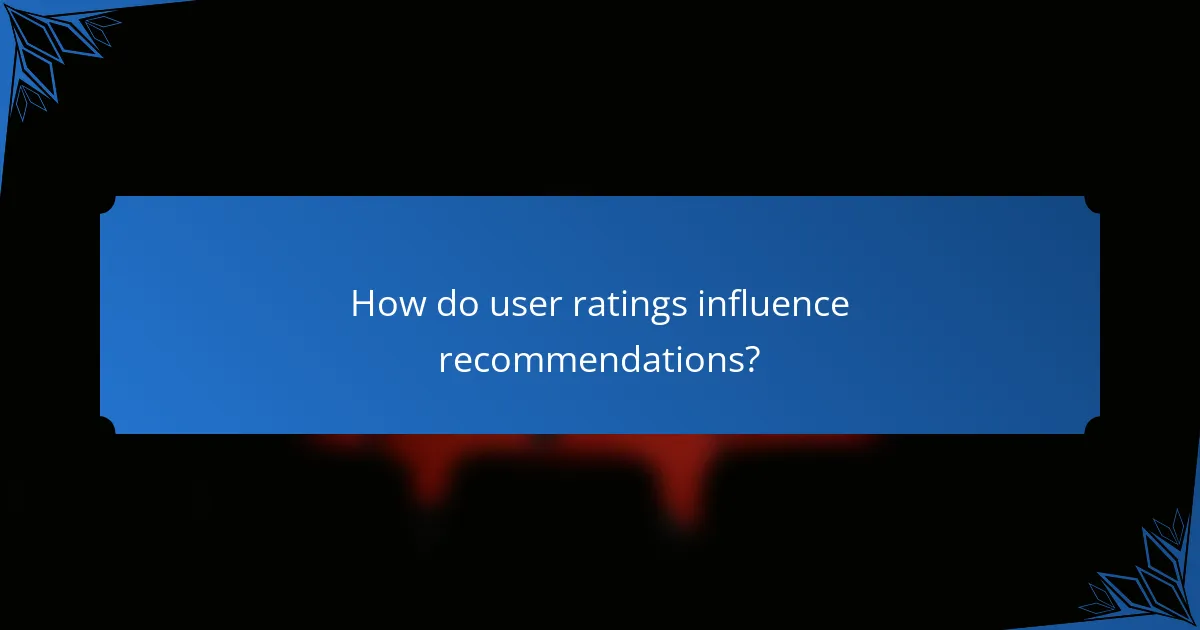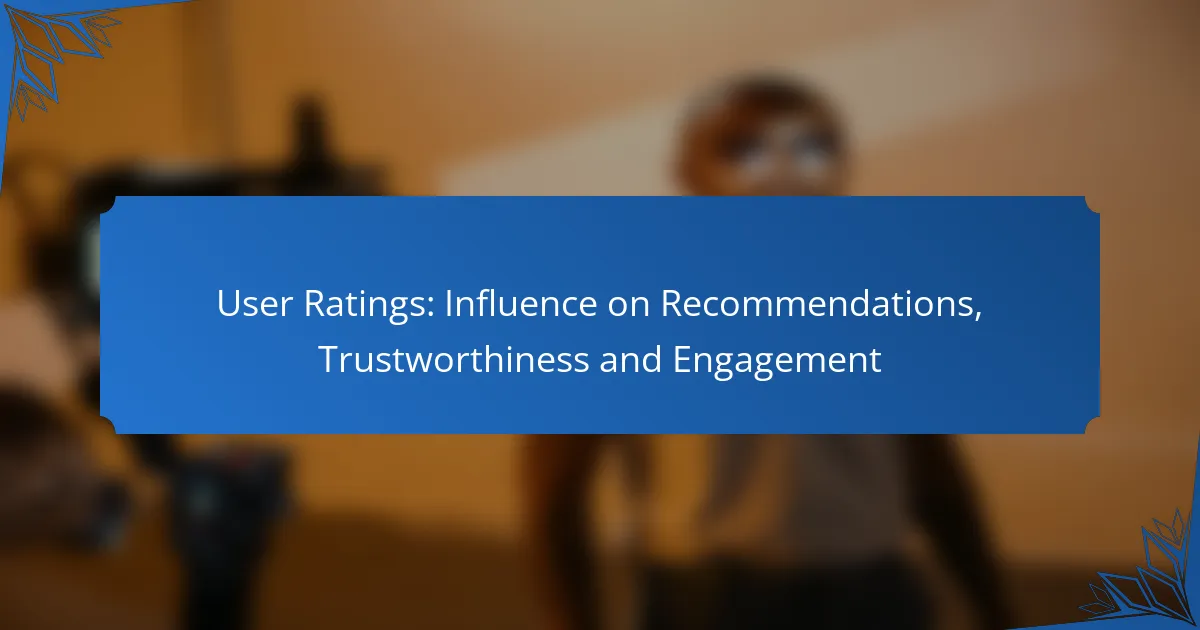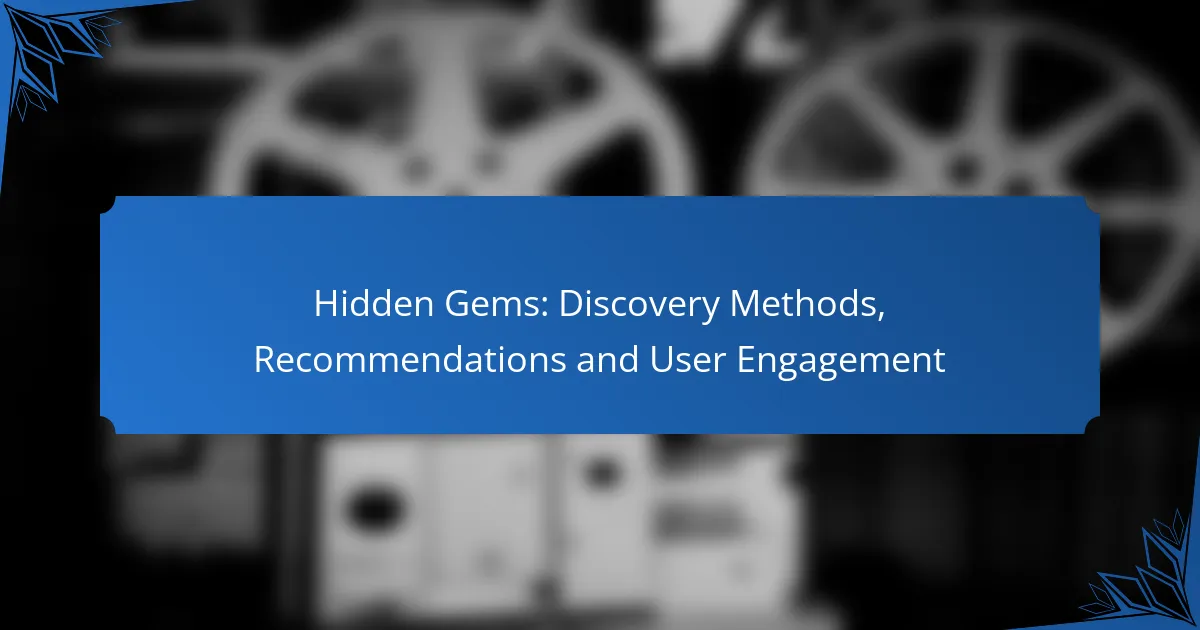User ratings play a critical role in shaping recommendations, enhancing visibility, and personalizing user experiences across various platforms. The trustworthiness of these ratings is essential, as it directly affects consumer confidence and engagement, ultimately influencing purchasing decisions. Positive ratings foster greater interaction, while negative feedback can hinder user engagement and trust.

How do user ratings influence recommendations?
User ratings significantly impact recommendations by shaping visibility and personalization across various platforms. Higher ratings often lead to increased exposure, while tailored suggestions based on ratings enhance user engagement and satisfaction.
Increased visibility on platforms like Amazon
User ratings play a crucial role in determining product visibility on Amazon. Items with higher ratings typically appear more prominently in search results and category listings, making them more likely to be seen and purchased by potential customers.
For sellers, maintaining a high average rating is essential. A rating above 4 stars can lead to better placement in search results, while products with lower ratings may struggle to gain traction. Regularly soliciting feedback and addressing customer concerns can help improve ratings over time.
Enhanced personalization in Netflix suggestions
On platforms like Netflix, user ratings directly influence the personalization of content recommendations. The algorithm analyzes ratings, viewing history, and preferences to suggest shows and movies tailored to individual tastes.
This means that users who consistently rate content will receive more accurate recommendations. Engaging with the rating system by providing feedback on watched titles can enhance the relevance of suggestions, leading to a more enjoyable viewing experience.

What is the role of trustworthiness in user ratings?
Trustworthiness in user ratings is crucial as it influences how consumers perceive and rely on feedback when making decisions. High trustworthiness enhances the credibility of ratings, leading to greater engagement and more informed purchasing choices.
Impact on consumer purchasing decisions
User ratings significantly affect consumer purchasing decisions by providing insights into product quality and user satisfaction. When potential buyers encounter high ratings, they are more likely to trust the product and proceed with the purchase, often prioritizing items with ratings above four stars.
Conversely, low ratings can deter consumers, even if the product has other appealing features. For instance, a product with a rating below three stars may be overlooked, regardless of its price or brand reputation.
Correlation with brand loyalty
There is a strong correlation between user ratings and brand loyalty, as positive ratings foster trust and repeat purchases. Customers who consistently see high ratings for a brand are more inclined to remain loyal, often becoming brand advocates who recommend the products to others.
On the other hand, negative ratings can lead to a decline in brand loyalty. Brands that fail to address low ratings or negative feedback risk losing customers to competitors who offer better-rated alternatives.

How do user ratings affect engagement levels?
User ratings significantly influence engagement levels by shaping user perceptions and interactions. Positive ratings can lead to increased trust and a higher likelihood of users engaging with content, while negative ratings may deter potential interactions.
Higher interaction rates on social media
User ratings often lead to higher interaction rates on social media platforms. When a product or service receives positive reviews, users are more likely to share their experiences, comment, and engage with related content. This creates a ripple effect, where increased visibility can attract even more engagement.
For instance, a restaurant with high ratings on review sites may see a surge in social media posts from satisfied customers, leading to greater brand awareness and community interaction. Brands should encourage customers to share their positive experiences online to maximize this effect.
Increased time spent on review sites
User ratings can lead to increased time spent on review sites as potential customers seek out information before making decisions. When users encounter high ratings, they are likely to delve deeper into reviews to understand the reasons behind the positive feedback.
For example, a product with a high average rating may prompt users to read multiple reviews, compare features, and assess user experiences. Businesses should ensure their profiles on review sites are well-maintained and highlight positive ratings to keep users engaged longer.

What criteria should be considered for evaluating user ratings?
Evaluating user ratings involves assessing factors such as rating distribution and the contextual relevance of reviews. These criteria help determine the trustworthiness and overall influence of ratings on consumer decisions.
Rating distribution analysis
Rating distribution analysis examines how ratings are spread across a range, typically from one to five stars. A balanced distribution, where ratings are evenly spread, often indicates a more reliable product or service than one with a skewed distribution heavily favoring high or low ratings.
When analyzing distribution, look for patterns such as the percentage of five-star ratings versus one-star ratings. For example, a product with 80% five-star ratings and 5% one-star ratings may suggest strong satisfaction, while a product with 50% five-star and 50% one-star ratings may indicate mixed experiences.
Contextual relevance of reviews
Contextual relevance of reviews refers to how well the content of user reviews aligns with the specific needs and preferences of potential buyers. Reviews that address particular features, usability, or customer service experiences can provide valuable insights beyond the star rating alone.
Consider the context in which a product is used. For instance, a tech gadget may receive positive reviews for performance but negative feedback regarding customer support. Evaluating both aspects helps consumers make informed decisions based on their priorities.

How do different platforms handle user ratings?
Different platforms manage user ratings in unique ways, influencing how consumers perceive businesses and products. Each platform has its own algorithms, user engagement strategies, and community guidelines that shape the visibility and impact of ratings.
Google Reviews vs. Yelp ratings
Google Reviews and Yelp ratings are both significant for local businesses but cater to different audiences. Google Reviews integrates seamlessly with Google Search and Maps, making it easier for users to find ratings while searching for services nearby. Yelp, on the other hand, focuses on user-generated content and detailed reviews, often attracting users looking for in-depth insights.
When considering which platform to prioritize, businesses should note that Google Reviews can enhance visibility in search results, while Yelp can build a reputation through detailed feedback. Engaging with reviews on both platforms can improve trustworthiness and customer engagement.
TripAdvisor’s impact on travel decisions
TripAdvisor plays a crucial role in shaping travel decisions by providing a platform for user-generated reviews and ratings of hotels, restaurants, and attractions. Travelers often rely on TripAdvisor ratings to gauge the quality and reliability of their options, making it a key resource in the travel planning process.
To leverage TripAdvisor effectively, businesses should encourage satisfied customers to leave positive reviews and respond to feedback to show engagement. High ratings can significantly influence potential travelers, leading to increased bookings and customer trust.

What are the emerging trends in user ratings?
Emerging trends in user ratings include the use of AI-driven sentiment analysis and the integration of video reviews. These innovations enhance the way businesses understand customer feedback and improve user engagement.
AI-driven sentiment analysis
AI-driven sentiment analysis utilizes machine learning algorithms to evaluate user ratings and reviews, determining the overall sentiment expressed. This technology can categorize feedback as positive, negative, or neutral, providing businesses with actionable insights into customer perceptions.
Companies can leverage sentiment analysis to identify trends in user ratings over time, allowing them to respond proactively to customer concerns. For instance, if a product consistently receives negative feedback, businesses can address the issues or improve the product to enhance customer satisfaction.
Integration of video reviews
Video reviews are becoming increasingly popular as they offer a more engaging and authentic way for users to share their experiences. By allowing customers to post video testimonials, businesses can showcase real-life usage and benefits of their products, which can significantly influence potential buyers.
To implement video reviews effectively, companies should encourage customers to share their videos on social media platforms or their websites. Providing incentives, such as discounts or contests, can motivate users to create and share video content, enhancing trustworthiness and engagement with the brand.

How can businesses leverage user ratings for growth?
Businesses can leverage user ratings to enhance their growth by building trust, improving customer engagement, and refining their offerings. Positive ratings can attract new customers, while constructive feedback helps identify areas for improvement, ultimately leading to increased sales and customer loyalty.
Strategies for improving review scores
To improve review scores, businesses should actively encourage satisfied customers to leave positive feedback. This can be achieved through follow-up emails, incentives, or making the review process simple and accessible. For example, a restaurant might offer a discount on a future visit in exchange for a review.
Additionally, responding promptly and professionally to negative reviews can mitigate damage and demonstrate a commitment to customer satisfaction. A well-crafted response can turn a dissatisfied customer into a loyal advocate if handled correctly.
Utilizing feedback for product development
Feedback from user ratings can provide invaluable insights for product development. Businesses should analyze trends in reviews to identify common pain points or desired features. For instance, if multiple users mention a lack of a specific functionality, it may warrant prioritizing that feature in future updates.
Moreover, conducting regular surveys alongside monitoring reviews can deepen understanding of customer needs. This dual approach allows businesses to stay ahead of market demands and refine their products effectively, ensuring they meet customer expectations and enhance satisfaction.



